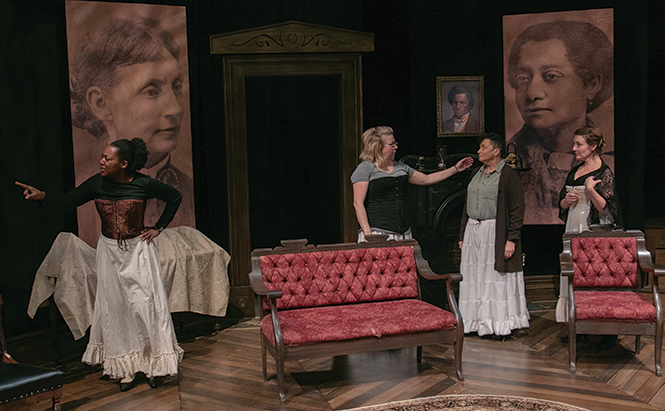Antagonistic Allies
Elaine Jarvik's new play explores the complexity of progressive movements with different priorities.
By Scott Renshaw @scottrenshawOn a Super Tuesday, Elaine Jarvik is talking about the challenge of progressive movements often butting up against one another over differing priorities. She just happens to be talking not about those of the moment, but issues that were causing friction more than 100 years ago.
Jarvik's world-premiere play Four Women Talking About the Man Under the Sheet—produced by Salt Lake Acting Co.—part deals in with the historical connection between women's suffrage leader Susan B. Anthony and abolitionist Frederick Douglass. But Douglass himself is not a character. Events begin on the day after his death on Feb. 20, 1895, as Anthony (Colleen Baum) visits his widow, Helen (Susanna Florence), at their home.
"They had this problematic relationship," Jarvik says of Anthony and Douglass. "A few weeks before, the annual convention of the National Women's Suffrage Association was in the south, in Atlanta. Douglass was going to come and be part of it. But Susan asked him not to show up, because she was trying to convince all of these Southern people to support suffrage, and to have a black man show up would upset them. ... What I wondered was, was there some guilt involved in her showing up [at the Douglass home]?"
At first, this fraught interaction wasn't going to be the subject of Jarvik's play. It was going to explore the connection between Utah suffragists and the national women's suffrage movement. "I began reading a lot of books, because it's easier to read a book than start writing," she says with a laugh. "Once I started writing, it was this grand sweep of history, more than 50 years—and it just wasn't working. I had coffee with my playwriting guru, Tim Slover, and he said, 'When you write about this big span of history, it's like skimming a stone across a lake. It's pretty, but you don't get the big splash.' So I just decided to abandon it."
While the change of direction that ultimately became Four Women Talking About the Man Under the Sheet narrowed that scope of history, it still dealt with historical figures—some of them revered. Jarvik felt the pressure and the responsibility of portraying these people in the play—partly the result of a set design by Justin Ivie that placed a large photo of Susan B. Anthony in the center of the action. "She was looking down on me during rehearsals all the time," Jarvik says. "I loved having her presence there, but I was also thinking, 'Was I doing this right?' There's a huge plot point about how you honor people from history, whether you ignore their flaws or embrace their flaws. I was nervous. So I just went with a little comedy. I guess I can just have fun with this, and I want the audience to have fun."
While the play's inciting incident focuses on Anthony's relationship with Frederick Douglass, the text also addresses Anthony's interaction with fellow suffragist Elizabeth Cady Stanton, who becomes a character in Four Women that is not physically present, but serves in a sense as Anthony's conscience. "[Stanton] has kind of been written out of the history of women's suffrage, because she was such a radical," Jarvik says. "She was a delightful person, really smart ... but she wanted to be this radical in the room. This was just one more thing that Anthony had to fight against—not just anti-suffragist men and women, but even her ally."
The notion of people who should theoretically be fellow fighters for progressive causes instead becoming antagonists certainly has a ring of familiarity in 2020, according to director Jason Bowcutt. "It has been an interesting process to rehearse this play while our political systems fight it out in real life," he says. "'Art imitating life' has felt familiar throughout."
Four Women tackles the complexity of intersectional progressivism head-on, including the character of Douglass's daughter Rosetta (Yolanda Stange), who approaches the idea of women's rights from the distinctive perspective of a woman of color. "She says she's a different kind of suffragist," Jarvik says, "saying to Susan, 'You don't know what it is to fight for certain kinds of things.' ... In the 19th century, the women's suffragist movement was mostly white, middle-class women. You saw this, I think, with the Women's March; when it started out, white women took it over. Black women were seeing their interests not being addressed."
Jarvik hints at a twist that brings the idea of the present day more directly, but it doesn't take a leap of logic to understand how such conflicts play out throughout history. Susan B. Anthony might be a historical hero who was driven toward a particular goal, in a way that perhaps made it hard to see the goals of others. "Like maybe a lot of activists," Jarvik says, "you want this one thing."
More by Scott Renshaw
-
Film Reviews: New Releases for April 19
The Ministry of Ungentlemanly Warfare, Abigail, The Beast, Hard Miles, Sasquatch Sunset and more
- Apr 19, 2024
-
Faces of Salt Lake County book and portrait reception
Images and personal stories in a new book reveal local demographic diversity
- Apr 17, 2024
-
Feature film review: THE BEAST
A filmmaker's compelling ideas get a bit tangled in references to his creative influences.
- Apr 17, 2024
- More »
Latest in Arts & Entertainment
Readers also liked…
-
New TV for January 2023
Mayfair Witches, Velma, The Last of Us, Poker Face and more premieres
- Jan 4, 2023




